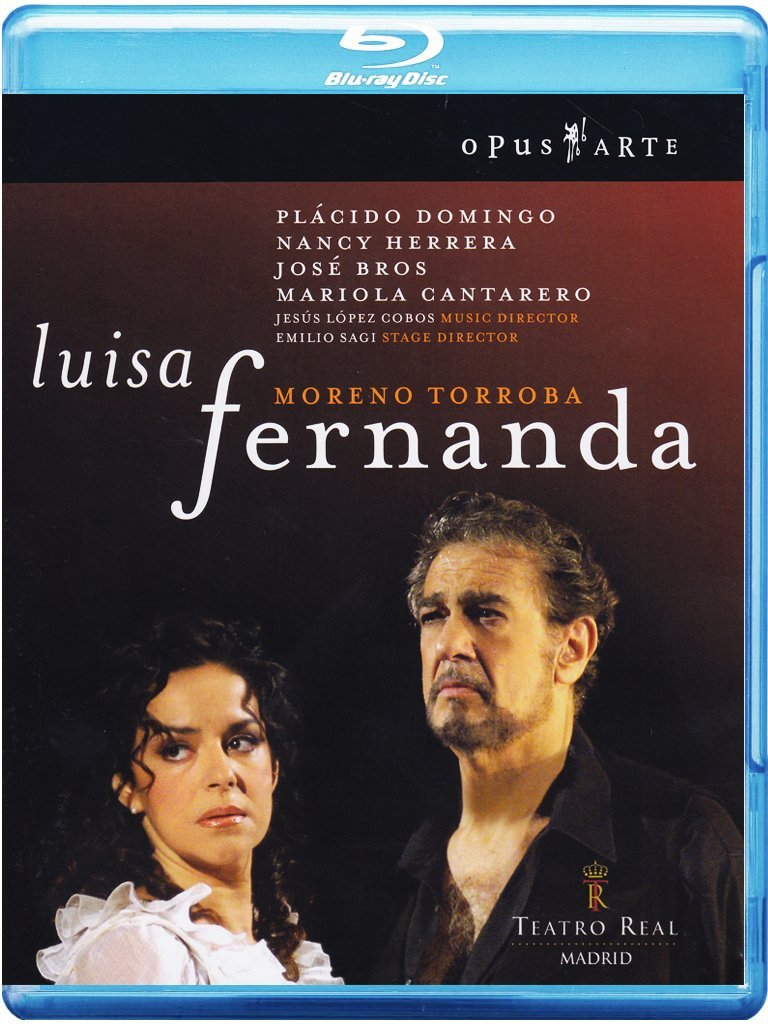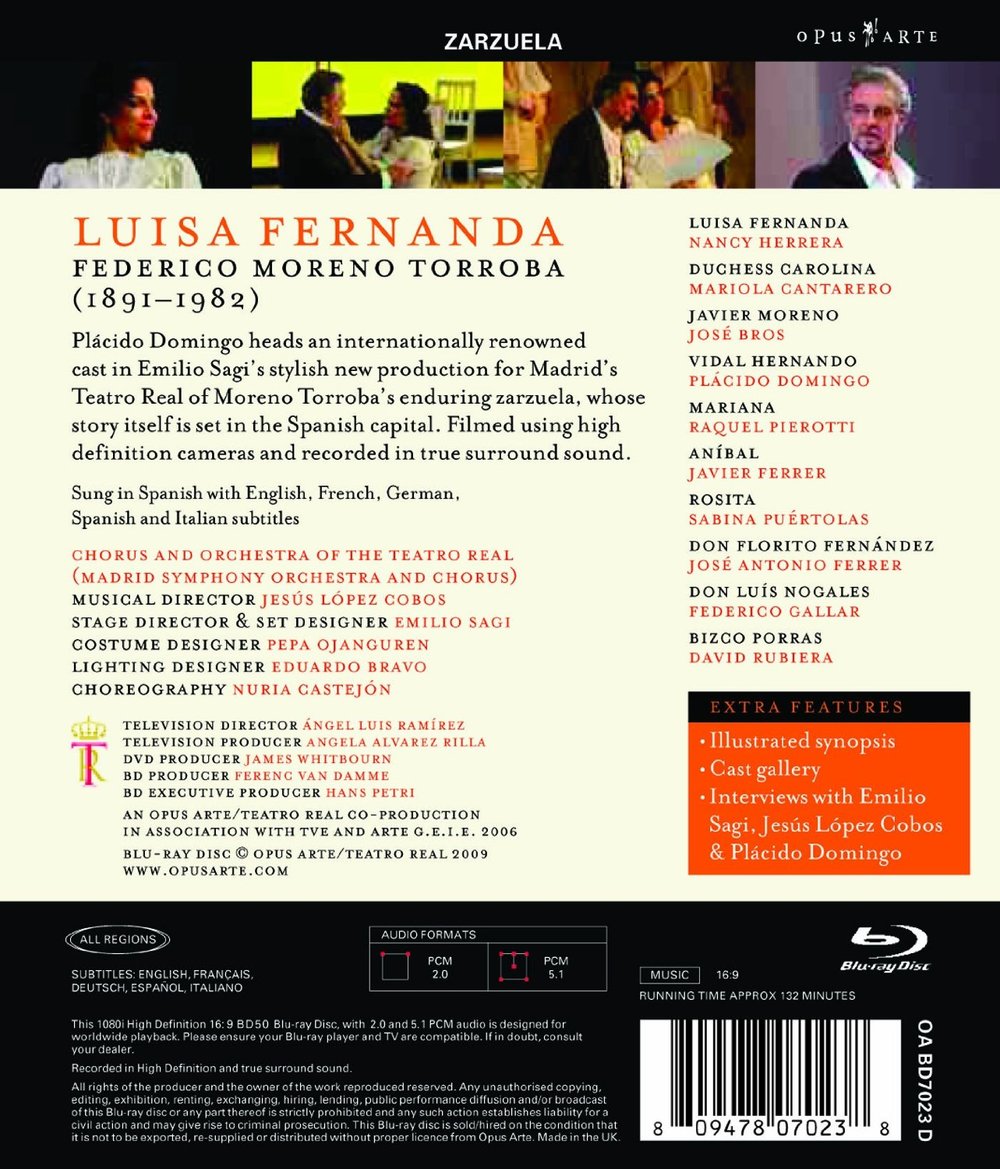

Federico Moreno Torroba Luisa Fernanda zarzuela to libretto by Federico Romero & Guillermo Fernández Shaw. Directed 2006 by Emilio Sagi at the Madrid Teatro Real. Stars Plácido Domingo (Vidal Hernando), Nancy Herrera (Luisa Fernanda), José Bros (Javier Moreno), Mariola Cantarero (Duchess Carolina), Raquel Pierotti (Mariana), Javier Ferrer (Aníbal), Sabina Puértolas (Rosita), José Antonio Ferrer (Don Florito Fernández), Federico Gallar (Don Luis Nogales), David Rubiera (Bizco Porras), Montserrat Muñumel (Coconut Seller), Ángel Rodríguez (Saboyard); Tomeu Bibiloni (Don Lucas), Juan Navarro (A Captain), Miguel Borrallo (First Guy), Julio Cendal (Second Guy), José Manuel Cardama (A Village Man), Juan Antonio Sanabria (Street Seller), and Joseba Pinela (Olive Shaker). Dancers are Celia Alturas, Cristina Arias, Olga Castro, Remedios Domingo, Ma Ángeles Fernández, Susana Gonzáles, Natalia Martín, Estefanía Palacios, Asunción Quintero, Silvia Rincón, Rodrigo Alonso, Fran Bas, Fermín Calvo, Eduardo Carranza, Jesús Gonzáles, Joaquín León, PedroNavarro, Joseba Pinela, Antonio Resino, and Juan Carlos Robles. Girls played by Martina Campo and Celia Clemente. Jesús López Cobos directs The Madrid Symphony Orchestra and Chorus (Chorus Master Jordi Casas Bayer). Set design by Emilio Sagi; costumes by Emilio Sagi and Pepa Ojanguren; lighting by Eduardo Bravo; choreography by Nuria Castejón; assistant stage direction by Javier Ulacia. Directed for TV by Ángel Luis Ramírez. Sung in Spanish. Released 2009, disc has PCM 5.1 sound. Grade: A
Per Wikipedia, zarzuela is a "Spanish lyric-dramatic genre that alternates between spoken and sung scenes, the latter incorporating operatic and popular song, as well as dance." I'm reminded of the German singspiels and historical pageants performed in the US. Luisa Fernanda is the most famous and the last great zarzuela to be written. It's been performed more than 10,000 times in Spain and South America.
My impression is that a complete performance of the Luisa Fernanda libretto lasts for more than 3 hours with a substantial history lesson, mostly in spoken dialog, and Luisa's love story, mostly in singing. This production directed by Emilio Sagi lasts a bit over 2 hours. Almost all of the spoken dialog was cut. This was appropriate because Sagi was originally hired to stage this as a concert version of the drama at La Scala. An Italian audience could not be expected to listen to an hour of lines spoken in Spanish. And there were, of course, no costumes or sets for the concert performance.
When Sagi had opportunity to present his Luisa Fernanda at the Teatro Real, he didn't restore the cut dialog. As Sagi himself explains in a bonus extra, his objective was to focus on the souls of the characters in Luisa's love story. A performance of the full Luisa Fernanda libretto would normally be supported with elaborate scenery depicting historic locations in the Madrid el centro and lavish period costumes. But Sagi saw no reason to recreate all the buildings and squares his audience could see for real just by walking for a few minutes around the opera house. So he went for an elegant modern update with lean sets and simple costumes for most of the cast. What Sagi wound up with was, although criticized by zarzuela experts as being too short, which suggests it’s an excellent show to introduce zarzuela to non-Spanish-speaking audiences.
In its shortened form, the plot is full of rapid twist and turns that can leave you dizzy. A synopsis on the disc helps, and you can find a full synopsis here by Christopher Webber. (Check out Webber's website at www.zalzuela.net.)
I can only give you the highlights of Luisa's love story. It's about 1886 in Madrid. Queen Isabella II is on the throne. The people are restless and agitating for a democratic Republic. On the right below is Javier (José Bros), a poor but ambitious commoner rising fast as an army officer. He's engaged to Luisa, but lately he's been neglecting her. In the center is Mariana (Raquel Pierotti), an innkeeper who knows everybody and is also a match-maker. On the left is Rosita (Sabina Puértolas) who lives at the inn and is busy looking for a man when she's not working mending clothes. Javier reminisces about his childhood in Madrid (standing near a model of downtown Madrid that reminds everyone where this is taking place):
Now we meet Luisa Fernanda (Nancy Herrera) and Vidal (Plácido Domingo). Vidal is a wealthy farmer who came to Madrid to find a wife. He met Mariana at the inn. Mariana has turned against Javier and has encouraged Vidal to court Luisa. Here Luisa turns down Vidal's sincere proposal of marriage, but you can see she's conflicted:
Vidal isn't going to give up on Luisa:
Next we meet Duchess Carolina (Mariola Cantarero) who is intimate with the Queen. Carolina lives in a palace right across the square from the Inn. Trying to shore up support for the Queen, Carolina is a cool political operator:
And the ambitions of poor boy Javier. . .:
The people of Madrid have to make a choice of government, and Luisa has to choose between two men. But let's take a time-out to meet some of the people of Madrid. We see a street festival:
And the girls who need a fiancé can appear on the day of Saint Anthony and pray for better luck:
And to dance with available suitors. Here we see the famous Mazurka of the Parasols. And on the left in the crowd, Duchess Carolina has Javier in tow. He has decided to support the Royalists against the Republicans!
Stealing kisses:
The Republicans Aníbal (Javier Ferrer carrying a mask) and Don Luis Nogales (Federico Gallar) try to recruit Vidal to their revolutionary cause:
And Duchess Carolina tries to bribe Vidal into supporting the Royalists. He has a clever way of turning her down:
Javier reveals himself as an unprincipled opportunist. He has turned against his own class by courting the Duchess, but he still expects Luisa to wait for him. Luisa is furious:
Lusia unloads on the Duchess:
Vidal has a great and noble heart, but he doesn't know much about politics. When Javier comes out for the Royalists, Vidal becomes a revolutionary! But he's really just fighting for Luisa's heart:
Luisa agrees to marry Vidal:
Now we are on Vidal's farm in Extremadura and everyone is celebrating the wedding to take place tomorrow:
The revolutionaries are victorious and Javier is defeated. He appears to try to win Luisa back. She pities and admits her love for him, but sends him away:
But Luisa can't hide her distress over Javier. Vidal senses this and nobly releases her to return to Javier:
Javier, always trying to ingratiate himself, tells Luisa to give Vidal one last kiss. Vidal's angrily says, "No."
In the libretto, Torroba and Shaw call for Luisa to leave with Javier, and that's the way the zarzuela has ended for 10,000 performances. Plácido Domingo, who knows more about this zarzuela than anyone else alive, declares in the bonus extra that Luisa is making a terrible mistake in leaving the magnanimous Vidal to return to feckless Javier. Why did Torroba end this way? Well, reflect for a moment on what was happening in Spain and all Europe in 1932. Spain had a weak democratic state. But everywhere the battle lines were being drawn between the fascists on the radical right and the communists on the radical left. Within 4 years, Spain would be in an atrocious civil war that would result in 35 years of totalitarian dictatorship under Franco. Torroba was not overtly political. But he was a devout Catholic and personally conservative. He hoped to stay in Spain (and stay alive) no matter what. He succeeded in this and lived long enough to see the beginning of democracy again in Spain. So in 1932, having shown sympathy with the commoners in his zarzuela and having given Luisa her brave speech in favor of equality of the classes, I surmise that Torroba hedged his bets by awarding Luisa in marriage to the royalist.
None of this was relevant by the time Sagi worked on his production of Luisa Fernanda. So he decided to be ambiguous in his ending. Luisa starts to leave with Javier as instructed by Vidal. But suddenly, she turns and starts walking back toward Vidal. As the lights go out, she's already closer to Vidal than to Javier, as you see below. So what is Luisa up to? There's no doubt in my mind. She's going to give Vidal a huge kiss and that will be the end of Javier. Well, actually I have a consolation prize for Javier. Remember Rosita from the first screenshot? She's waiting for him back in Madrid.
I assume Luisa Fernanda is still under copyright (perhaps under the 95 year rule beginning in 1932). I assume Sagi had acquired production rights from the relevant heirs and assigns of Torroba and the librettists. But could changing the libretto have violated moral rights of survivors under Spanish copyright law? Maybe Sagi had to be careful about this—so all he did was have Luisa silently walk a few steps towards Vidal. But in your imagination, you can end the drama as you please:
Once you learn about the origin of Sagi's production and its focus on the souls of the characters, you can see what a wonderful production this is for introducing strangers to zarzuela. The music, directing, acting, staging, and recording for HDVD are all admirable and justify my A grade.
PS: If you want to learn more about Torroba, try Federico Moreno Torroba, A Musical Life in Three Acts by Walter Aaron Clark & William Craig Krause. Oxford University Press 2013 ISBN 978-0-19-531370-3 (356pp). It got rave reviews. Here's the front cover:
OR























